Jungle Scout now offers Amazon sellers a completely automated review request experience with Review Automation. With one click, Jungle Scout users can automatically send review requests for all eligible orders.
This feature allows sellers to eliminate the tedious task of manually requesting customer feedback on Seller Central so they can earn more reviews while investing time back into their businesses.
Click here for a user guide to Review Automation or read more about how automating the review request process can benefit your business.
And check out our guide for more strategies on how to get reviews on Amazon.
In late 2019, Amazon introduced a new way for Amazon sellers to request reviews from their customers within Seller Central: Amazon’s “Request a Review” button.
This feature is easy to access and can help you boost your product reviews and ratings, helping you to be more competitive on Amazon.
We’ll explore how the “Request a Review” button works and introduce you to a new tool that automates sending review requests to your customers all at once — a powerful new feature of Jungle Scout’s.
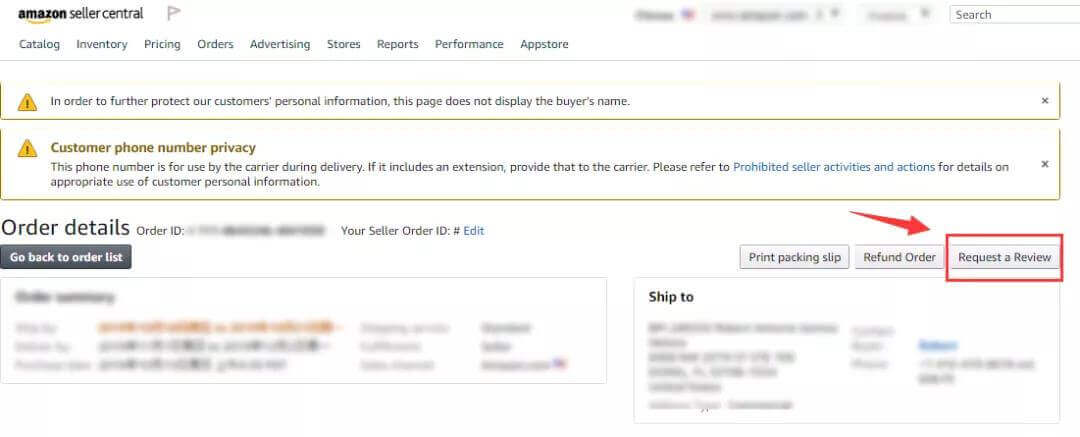
What is Amazon’s “Request a Review” button?
Amazon’s “Request a Review” button appears in a user’s Seller Central account in a unique order’s ‘Order details’ section. Upon clicking the button, Amazon presents sellers with this page:
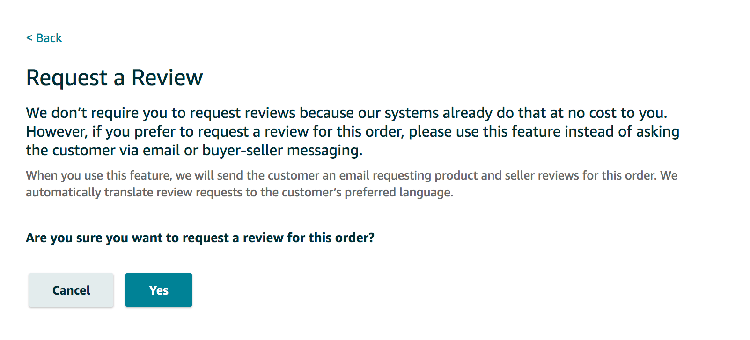
It reads:
Request a Review
We don’t require you to request reviews because our systems already do that at no cost to you. However, if you prefer to request a review for this order, please use this feature instead of asking the customer via email or buyer-seller messaging.
When you use this feature, we will send the customer an email requesting product and seller reviews for this order. We automatically translate review requests to the customer’s preferred language.
Are you sure you want to request a review for this order?
After clicking yes, you get this final screen:

It reads:
Request a Review
A review will be requested for this order. (Note: We will suppress this request if a review has already been requested for this order)
Once the initial review request is sent, you cannot send a follow-up to that same customer. This is likely Amazon’s attempt to stop sellers from spamming customers.
Note that some sellers are able to send requests for reviews within hours after an order is placed, while others receive a message informing them that they have to wait at least four days after delivery before sending a request.
What does the “Request a Review” email look like?
We received Amazon’s “Request a Review” email four days after purchasing fundraising bracelets from the online store. This is what we received:
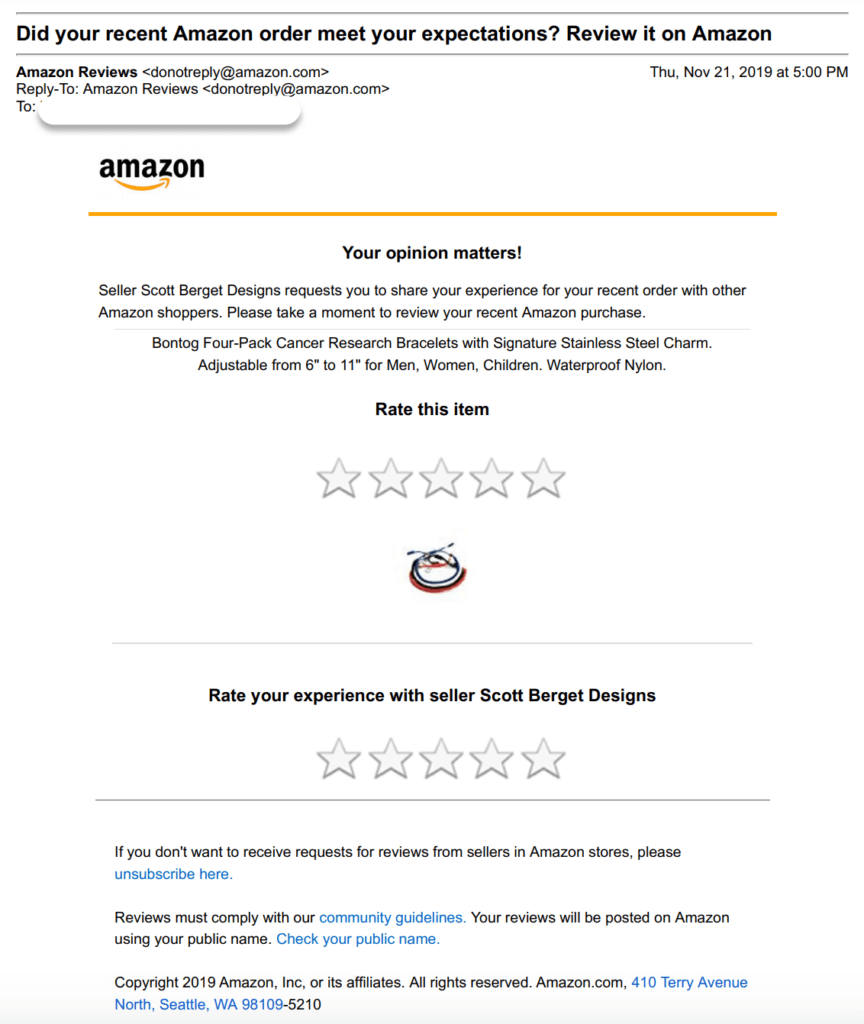
Along with the links at the bottom of the email, two clickable 5-star graphics take buyers to their Amazon account where they can leave both a star-rating and a review. And above those, the copy of the email reads:
Did your recent Amazon order meet your expectations? Review it on Amazon
Your opinion matters!
Seller Scott Berget Designs requests you to share your experience for your recent order with other Amazon shoppers. Please take a moment to review your recent Amazon purchase.
Bontog Four-Pack Cancer Research Bracelets with Signature Stainless Steel Charm. Adjustable from 6″ to 11″ for Men, Women, Children. Waterproof Nylon.
Aside from the title of the product purchased, the email offers no customer-personalization. This is likely to ensure that all review requests contain the same information: the seller’s name, the product’s title, and a link to the shopper’s Amazon account.
How the “Request a Review” button works
The “Request a Review” button seeks to replace outside messaging systems and email contacts.
In late 2019, Amazon totally removed contact information from Order Details, including last names and shipping addresses. At most, sellers are able to see the first name of the buyer and the city they live in.
And while sellers can still use tools such as Jungle Scout’s Promotions & Email Campaigns feature to send customers customized messages (including requests for reviews), these are funneled through Amazon to protect customer contact information.
Also, the “Request a Review” option is only available once per sale. Using Amazon alone, sellers must manually click to request a review for each order, rather than automating email requests to all customers.
However, Jungle Scout released a feature to simplify and automate these review requests.
Automate Amazon’s “Request a Review” button with Jungle Scout
With Jungle Scout, you can now request reviews for your Amazon orders in bulk.
Built directly into your browser, Jungle Scout allows you to find and validate FBA product ideas. Now it also enables you to access the “Request a Review” button and automate review requests on all of your orders at once.
How to request Amazon reviews in bulk:
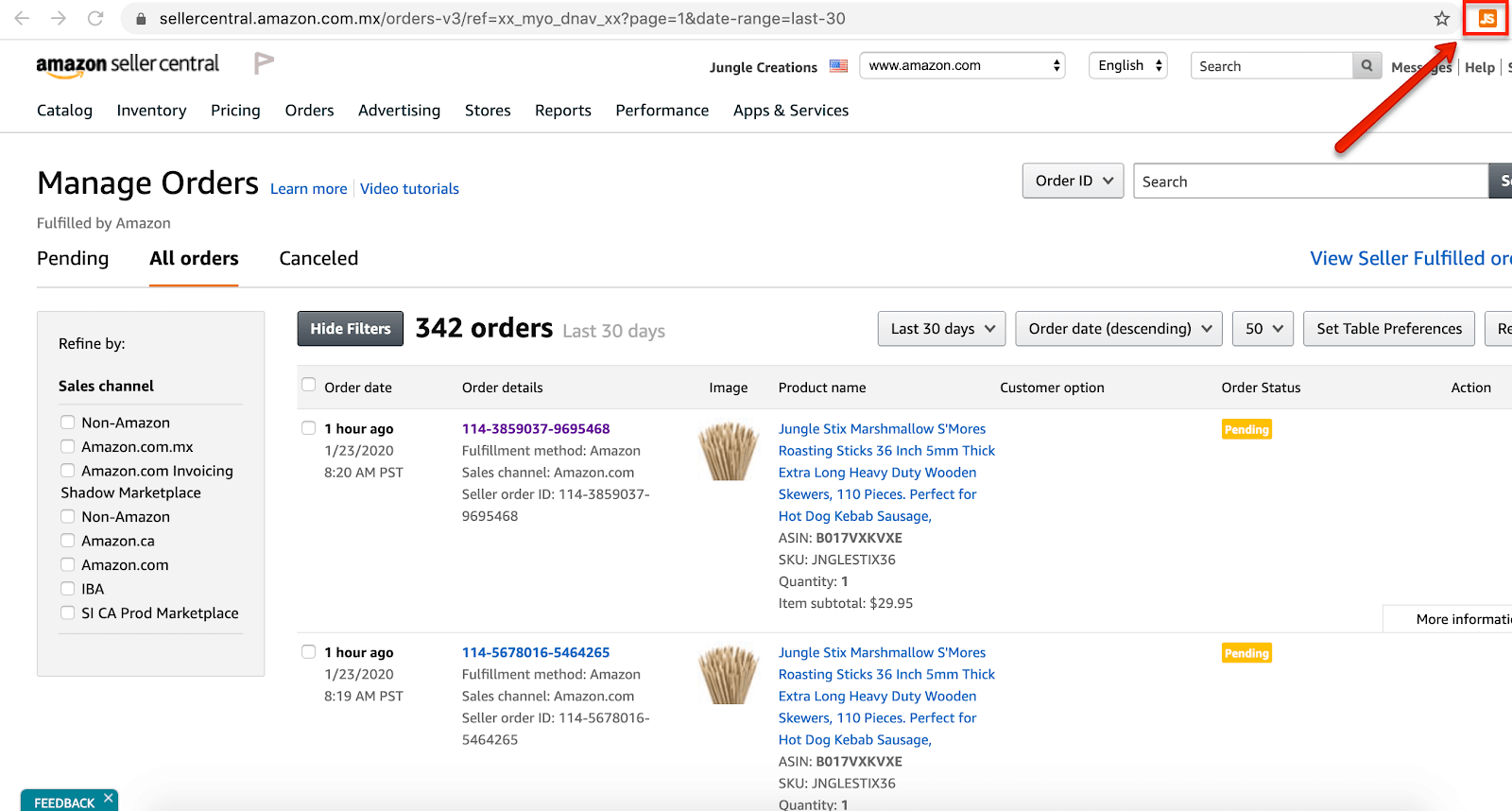
To access this new feature, log on to Seller Central and click on Orders, and then Manage Orders. Next, click the ‘JS’ button on your Chrome’s toolbar as if you were going to open your extension. When you do, it will ask for you to allow additional permissions.

Click on the button that reads ‘Click here for instant access.’ As soon as you do, you’ll get a prompt from the browser requesting additional permissions. Click ‘Allow.’
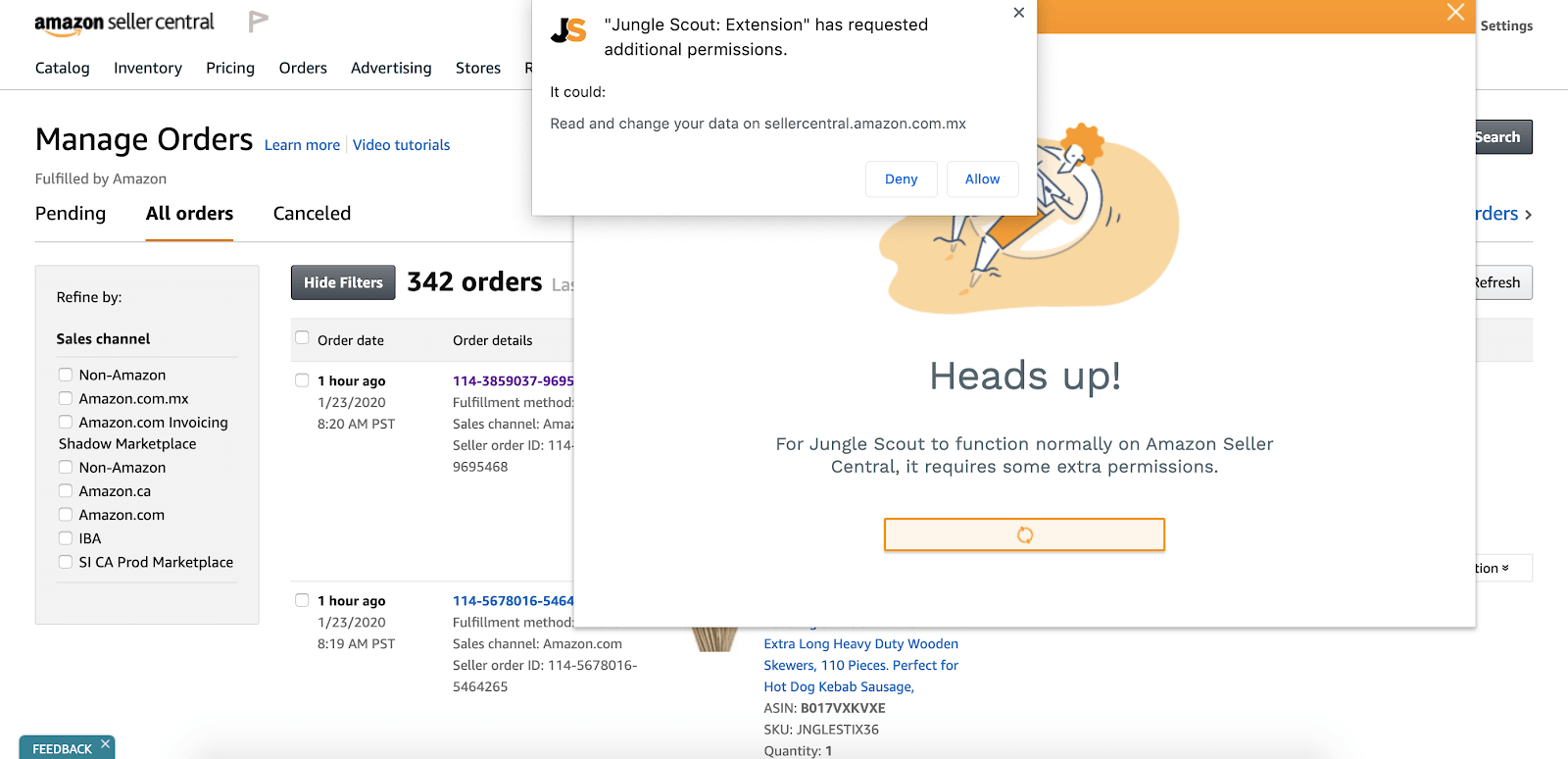
Immediately, your Orders page will reload and new orange buttons will appear along with the other ones.
First, at the top, right beside the Order page’s filters, you’ll see an orange button that allows you to ‘Request Reviews on This Page.’ This automatically clicks each “Request a review” button for every order on that page that qualifies.
In addition to the bulk request functionality, each order now has a button that allows you to send the request from the Manage Orders page instead of the Order’s individual page, saving you an extra click or two.
If the order is not ready for a review — because it’s not within the time frame or you’ve already sent a review request — you will not be able to click on this button.
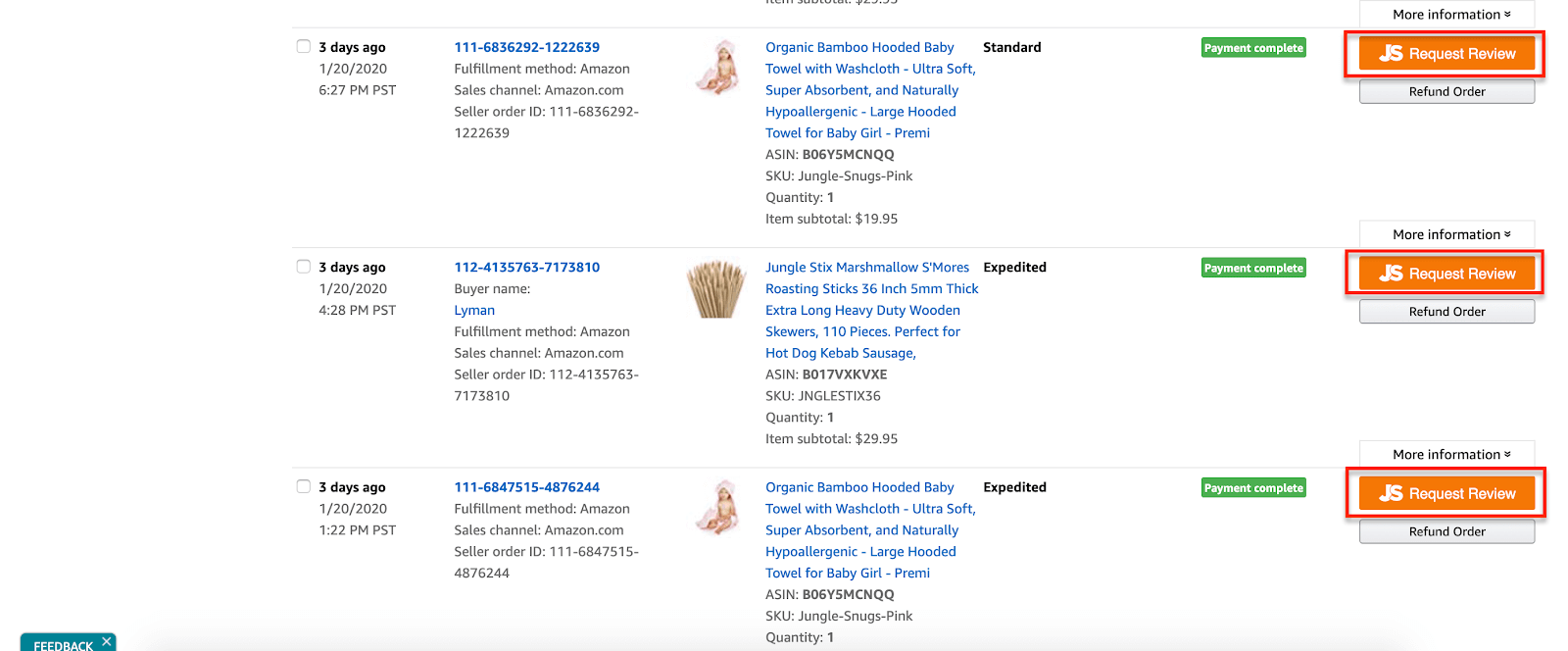
This new feature is included at no extra cost within Jungle Scout’s Chrome extension.
What does Amazon’s “Request a Review” mean for sellers?
This new “Request a Review” option indicates that Amazon prefers an in-house automated method for sellers to source customer reviews for their products — a notoriously difficult task.
Currently, Amazon prohibits sellers from:
- Incentivizing reviews: Before October 3, 2016, sellers could offer free or heavily discounted products in exchange for reviews.
- Using manipulative language: In product inserts, emails, and any other seller-to-shopper communication, sellers cannot use manipulative language to seek reviews. Phrases like “we are a family-owned business” and “our products are made in the USA,” will get you in trouble with Amazon.
- Cherry-picking: Sellers cannot seek reviews only from shoppers they know had positive experiences with their products.
So, the introduction of a “Request a Review” button could mean a few different things for sellers.
On the one hand, the button could make it easier for sellers to receive hard-to-get product reviews. This is important because each review has the potential of increasing a product’s sales on Amazon — even if it means clicking a few more buttons to get there.
Furthermore, if the message comes from Amazon, rather than a specific seller, customers may view the request as more credible. That could, potentially, increase the likelihood that a customer will leave a review.
However, it could also mean Amazon wants to tighten its grip on seller-to-customer communications. Or even to remove seller-to-customer communication altogether.
Regardless, since the release of the “Request a Review“ button (and the fact that sellers can continue to use services such as Jungle Scout’s Promotions & Email Campaigns to contact buyers to leave seller feedback and a product review), our data* shows a significant change in average review increase for those who click the button.
After looking at Amazon product listings for two weeks prior to the release of “Request a Review” on March 8, 2020, and again for the two week post-launch, we noted that 94.7% of sellers who used “Request a Review” experienced a jump in reviews — from an averaged increase of 3.6 to a whooping 25.9.
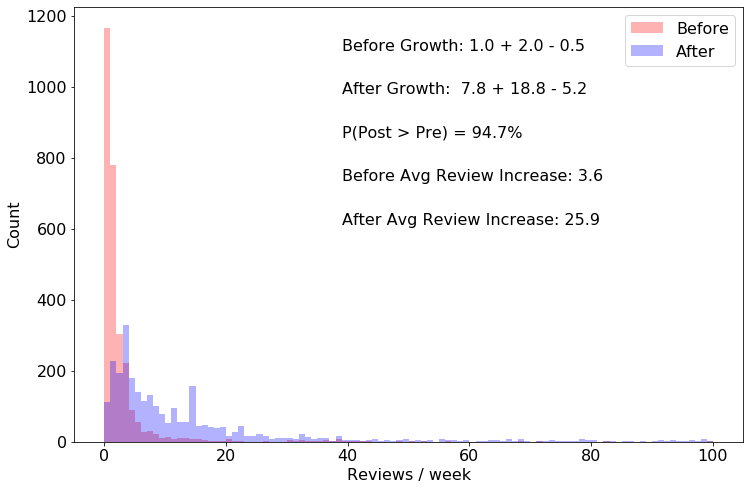
That’s a massive difference and a positive change for those Amazon sellers choosing to use this new tool.
Is it in all markets yet?
Yes! This functionality — in addition to Jungle Scout’s bulk “Request a Review” tool — is available in all marketplaces.
Alternatives to Amazon’s “Request a Review” button
While Amazon has this straightforward new feature for sellers to contact customers about leaving reviews, there are multiple alternative contact methods you can use to encourage reviews (including — shameless plug — Jungle Scout).
Some features that might be important to sellers included with Jungle Scout that Amazon’s “Request a Review” button does NOT have:
- Send unlimited messages. The “Request a Review” button only allows for one message to be sent to a customer, whereas Jungle Scout allows you to send as many requests as you like (although we don’t recommend more than two or you risk irritating your customer).
- Customize the messaging. With Amazon’s “Request a Review” option, you have no say in the messaging being sent to the customer. Jungle Scout lets you customize your message based on your Amazon business, products, or brand, or you can use one of Jungle Scout’s built-in templates.
- Review your statistics. Jungle Scout offers statistics on the types of communications you’re sending, as well as how often you’re sending them.
*Disclaimer: This article was updated on May 8, 2020 to reflect data regarding the efficacy of the “Request a Review’”button.
Follow us on Twitter and Facebook for updates. And don’t forget! If you have any thoughts on how a “Request a Review” button could impact your Amazon business, let us know in the comments below. We’d love to hear from you!

 79 Comments
79 Comments
79 comments on “Jungle Scout Automates Review Requests for Amazon Sellers”